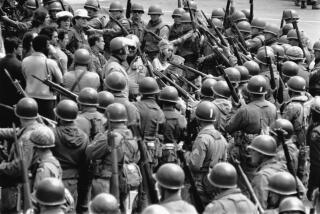L.A. Summer Job Program for Youths Facing Cutback
At a time when gang activities have escalated in Los Angeles, the city will have to cut back the number of people it hires in its federally financed summer job program, officials said.
Jane Dawson, the program director, said Monday that while money available for the program will be about the same as last year--a little more than $11 million--increases in wages paid to youngsters as a result of minimum-wage hikes will necessitate a cut of “a few hundred” from the 9,372 employed last year.
She said the standard pay this summer will be $4.25 an hour, reflecting the rise in the state’s minimum wage. It was $3.35 in 1987.
Dawson said cuts in the number of those employed will be minimized as much as possible by running the program with fewer staff members and over-enrolling youngsters slightly to compensate for those who quit or end up not working full time.
The program director expressed relief that earlier indications from federal authorities of an actual cutback in funds to $10 million had been reversed. She said that would have forced a cutback in the hours of work, as well as numbers.
The eight-week program employs job-needy young people for five hours a day on a variety of government projects. The jobs include child care, senior citizen care, clerical, maintenance, recreation, hospital aid, food handling, teachers’ aide and community improvement.
In 1987, 42.2% of those employed were blacks, 38.2% Latinos, 14.6% Asian and Pacific islanders, 0.5% native Americans and 4.5% white. Dawson said that about 70% of the total came from South and East Los Angeles, areas heavily affected by gang problems.
Figures provided by the U.S. Bureau of Labor Statistics on Monday show that over the last five years, minority youth unemployment has gone down considerably, although the available figures are not for the summer months.
As of 1987, for instance, an average 16.2% of 89,000 Latinos,
ages 16 to 19 who were in the labor force in Los Angeles County, were unemployed. This compared with 19.8% in 1986, 22.7% in 1985 and 28.1% in 1983.
The bureau has no Los Angeles County figures for blacks, but its statewide figures put black unemployment for ages 16 to 19 at 22.3% in 1987, contrasted with 40.9% in 1985 and 46.4% in 1983.
Mixed Feelings
Although there are fewer unemployed youths who might seek available jobs, two officials of urban and minority groups expressed disappointment Monday that the jobs program is being cut back at all. At the same time, the officials said they had mixed feelings because they favor minimum-wage increases.
“I’m pleased to hear that those youngsters who will be working will be receiving higher wages . . . , “ said John W. Mack, president of the Los Angeles Urban League. “It’s important that our youth receive wages that will make street life less attractive to them.”
But, he added, “it’s regrettable that more dollars were not made available by the federal government . . . .”
“The cost of living goes up from year to year. Allocations should not be on an ‘as usual’ basis,” he said.
Frances James, a member of the executive board of the South-Central Organizing Committee, said, “We’re very concerned that youth would be deprived of jobs merely because of a moral (proper) increase in the minimum wages.”
The city youth job program dates from 1965, although it has undergone three name changes since then.
More to Read
Start your day right
Sign up for Essential California for news, features and recommendations from the L.A. Times and beyond in your inbox six days a week.
You may occasionally receive promotional content from the Los Angeles Times.






